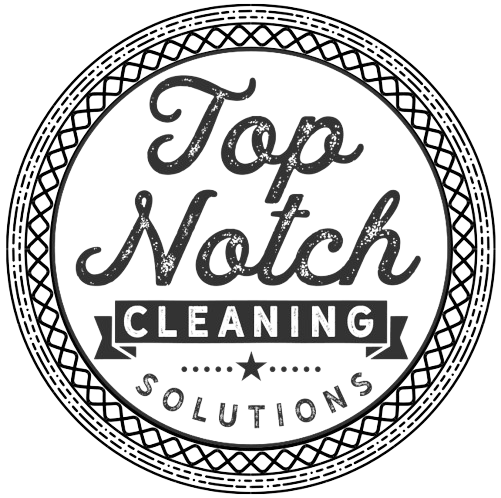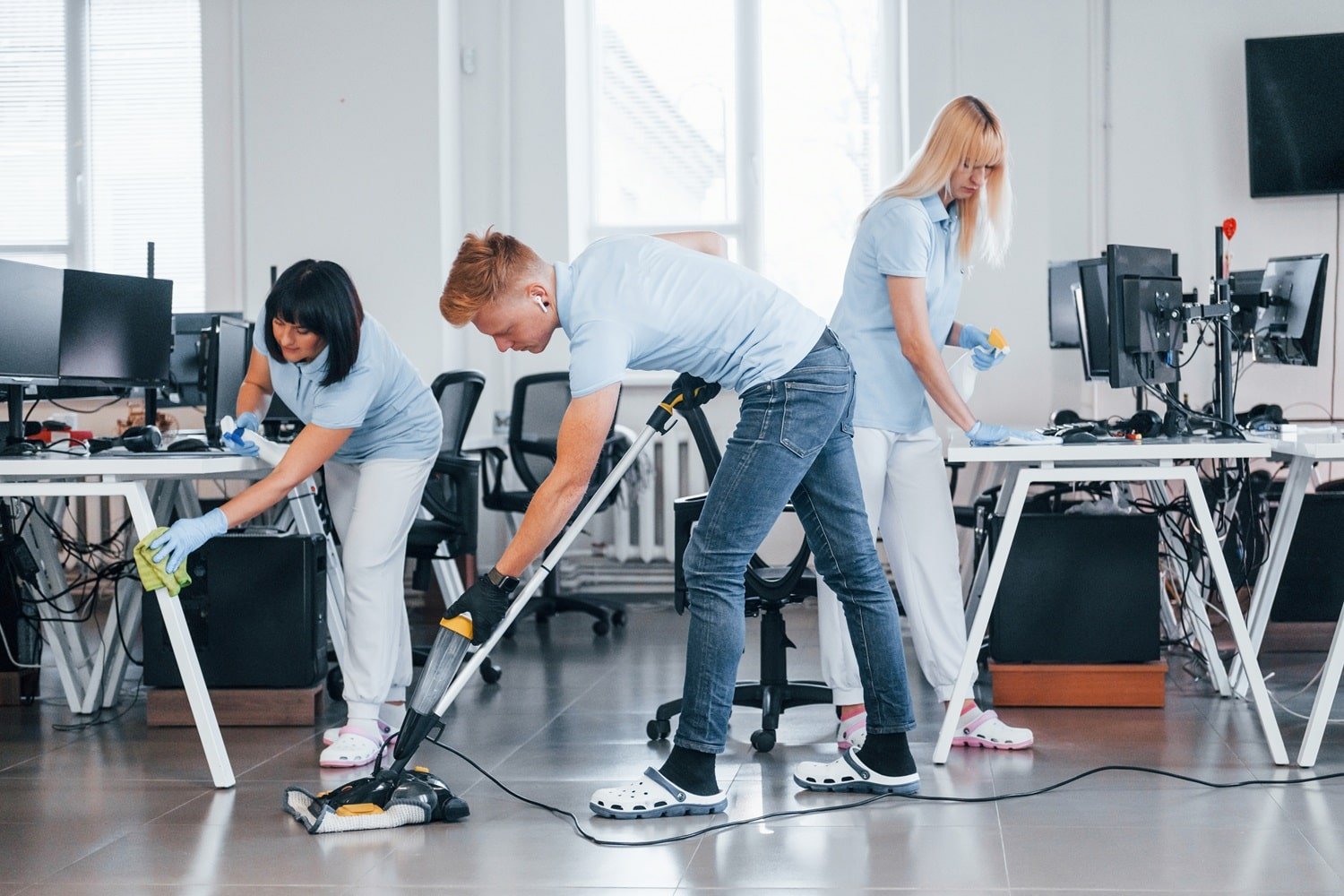Establishing a Positive Work Environment

A clean office is integral to nurturing a positive work environment where employees can thrive and customers receive an impeccable impression of the company. It is a place conducive to high morale, enhanced productivity, and reflective of the organization’s professionalism.
Boosting Employee Morale and Productivity
Employee morale and productivity are inherently linked; a well-maintained office can significantly increase both. A study by HLW International LLP showed that cleanliness in a workspace can lead to a 5% increase in productivity—a clear indicator of efficiency gains.
- Clean and organized workspace: Reduces distractions, allowing employees to focus.
- Sanitary environment: Supports employee health, reducing sick days.
Creating Lasting First Impressions for Customers
First impressions are pivotal for customer relations, and the state of the office space plays a crucial role. Customers often gauge the quality of service by the cleanliness of a workspace, affecting their overall satisfaction and potential for long-term business.
- Welcoming environment: Signifies attention to detail.
- Orderly space: Communicates competence and reliability.
Cultivating Professionalism and Brand Image
Professionalism and brand image are reflected through the upkeep of workspace. Employees’ morale is intertwined with the workplace ambiance, affecting their engagement and thereby shaping the brand’s public perception.
- Consistent cleanliness: Fosters a positive work environment.
- Attention to detail: Reinforces the company’s commitment to excellence.
Through intentional upkeep and maintenance, a clean workspace is vital in establishing a positive, productive, and professional atmosphere for all stakeholders involved.
Health and Safety in the Workplace

Maintaining a clean office is pivotal not only for aesthetics but also for the health and safety of employees. A rigorously upheld clean environment reduces the spread of pathogens, cuts down on workplace accidents, and complies with health regulations.
Reducing Illness and Absenteeism Through Cleanliness
Regular sanitation procedures are crucial in curtailing the spread of germs and minimizing the risk of illness. Clean workplaces lead to fewer sick days taken by employees. For instance:
- Germs: High-touch areas such as doorknobs and keyboards harbor bacteria and viruses.
- Sick Days: A decline in contaminants theoretically results in reduced absenteeism, as there are fewer illness transmissions.
A study into workplace wellness indicated that offices adhering to a cleanliness protocol saw a significant decrease in the number of employee sick days.
Adhering to Health Regulations and Ensuring Safety
Compliance with health standards is essential for a safe workplace. Safety can be compromised by various forms of dirt and clutter:
- Regulations: Businesses must meet certain cleanliness criteria to pass health inspections.
- Accidents: Removal of spills and debris is necessary to prevent trips and falls.
By sustaining a clean office environment, companies not only meet legal requirements but also foster a safe working space where accidents are less likely.
Improving Air Quality and Reducing Allergens
The quality of indoor air is an often-overlooked aspect of workplace health:
- Particulate matter such as dust and mold spores can exacerbate respiratory conditions.
- HVAC systems: Regular maintenance and cleaning of heating, ventilation, and air conditioning systems are necessary to prevent the circulation of allergens and contaminants.
Investing in high-quality, HEPA-filter based air purification systems can drastically improve office air quality, helping to prevent complications arising from poor air standards.
Organizational Efficiency and Focus

A clean office environment is integral for enhancing organizational efficiency and maintaining focus. Clutter-free workspaces and well-maintained equipment contribute to streamlined task management and reduced stress levels.
Minimizing Distractions and Enhancing Concentration
Clutter serves as a visual distraction, leading to decreased focus and productivity. A study has shown that individuals working in a clean and organized office can concentrate better, making them more efficient in their tasks. To minimize distractions, it is recommended to:
- Maintain a clean desk policy, ensuring that only essential items are within sight.
- Implement a regular cleaning schedule to prevent the accumulation of clutter and dirt.
Streamlining Task Management and Minimizing Stress
Efficiency in task management is greatly influenced by the state of the workplace. An organized office:
- Reduces the time spent searching for papers and documents, leading to a smooth workflow.
- Lowers stress levels as workers can locate the necessary equipment and documents without unnecessary frustration.
Stress management is critical, and cleanliness plays a significant role in creating a calming environment, which in turn promotes a tranquil and productive work atmosphere.
Maintaining Organized Office Space and Equipment
Maintaining a clean and orderly office space and equipment is essential. Proper maintenance ensures:
- All equipment such as keyboards, mice, and monitors are cleaned and functioning properly.
- Office space is optimized for easy movement and access, preventing safety hazards and fostering an effective work environment.
Professional office cleaning services can be employed to ensure that the workspace remains pristine, which has been shown to encourage increased efficiency amongst employees.
Office Cleanliness and Maintenance Best Practices

Creating an environment that maintains high standards of cleanliness and hygiene is essential for any office. This ensures a healthy and appealing work setting while also reducing the risks associated with cross-contamination.
Implementing Regular Cleaning Schedules
Regular cleaning schedules are the backbone of office cleanliness. To maintain hygiene and aesthetics, offices must have a clear cleaning plan. A daily schedule should include tasks such as vacuuming, wiping down surfaces, and disposing of trash. Additionally, weekly tasks might involve mopping floors and deep cleaning high-touch areas. It is critical to include monthly or quarterly schedules for comprehensive cleaning that includes steam cleaning carpets and polishing furniture.
- Daily:
- Vacuum carpets
- Clean spills
- Disinfect desks and phones
- Sanitize door handles
- Weekly:
- Mop floors
- Clean windows
- Dust fixtures
- Monthly/Quarterly:
- Steam clean carpets
- Polish wood surfaces
- Deep clean restrooms
Choosing the Right Cleaning Company
Selecting the right cleaning company plays a crucial role in maintaining office cleanliness. Offices should seek companies with a strong reputation for reliability and thoroughness. Ensure they use proper disinfectants to reduce the spread of germs and that their janitorial team is trained to handle various types of spills and stains. The chosen company should also be adept at preventing cross-contamination between different office areas.
Addressing Common Office Areas: Desks and Restrooms
Desks and restrooms represent common areas that need frequent sanitization to prevent the build-up of bacteria and viruses.
- Desks: Employees spend much of their time here, making them a hotspot for germs. Daily disinfecting of desk surfaces, keyboards, and phones is essential.
- Restrooms: They require constant maintenance to keep them clean and hygienic. Regular tasks should include restocking of supplies, sanitizing fixtures, and performing deep cleaning to maintain the cleanliness and functionality of these spaces.
Incorporating these best practices ensures that offices can maintain a clean and healthy environment for all employees and visitors.
Frequently Asked Questions

These common inquiries reveal the crucial role a clean office plays in productivity, health, corporate image, safety, financial benefits, and employee well-being.
How does a clean office environment impact employee productivity?
A clean office environment reduces distractions and clutter, allowing employees to concentrate better on their tasks. Studies indicate that workers in hygienic and orderly spaces are generally more productive.
What are the health benefits of maintaining a clean workplace?
Keeping a clean workplace minimizes the spread of germs and bacteria, thus reducing employee sick days. Regular cleaning also mitigates allergy triggers such as dust and mold.
How does workplace cleanliness influence client perceptions of a business?
A clean and well-maintained office fosters a professional image, which can enhance a client’s trust and confidence in a company. First impressions are often linked to the cleanliness of the business environment.
In what ways does a tidy work area contribute to workplace safety?
A tidy workspace reduces hazards that can cause slips, trips, and falls. Ensuring clear walkways and properly stored items helps in mitigating potential accidents.
What are the economic advantages of keeping a clean and organized office?
A clean office can lead to lower maintenance costs over time, as regular upkeep helps prevent wear and tear. It can also lessen the frequency of costly deep cleanings or replacements due to neglect.
How can a clean work environment affect employee morale and job satisfaction?
Employees typically feel more valued and take greater pride in their work when their environment is clean. This can lead to increased job satisfaction, lower turnover rates, and a stronger commitment to the company.

